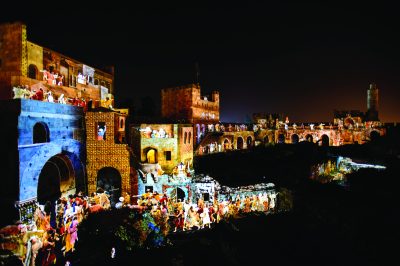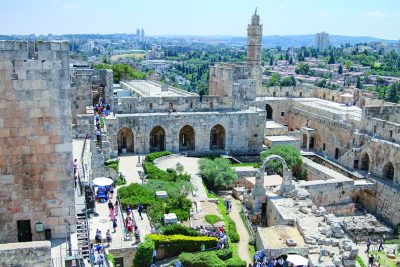×


We have detected your country as:
Please click here to go to the USA website or select another country from the dropdown list.
by: Terry Mason, Director of International Development
 If you are looking for a dynamic experience on your next visit to Jerusalem, I highly recommend a visit to the Tower of David Museum. Even if you’ve visited before, the revamped and updated museum opened its doors in June to the public after a three-year, US $50 million renewal and conservation upgrade. Many who have visited Jerusalem in the past will know the Tower of David Museum from attending the Night Spectacular light show, an extravaganza of sight and sound projected on the ancient stone walls that recounts the history of Jerusalem. However, there is so much more to this fascinating, expansive museum complex—and now it is even better than ever.
If you are looking for a dynamic experience on your next visit to Jerusalem, I highly recommend a visit to the Tower of David Museum. Even if you’ve visited before, the revamped and updated museum opened its doors in June to the public after a three-year, US $50 million renewal and conservation upgrade. Many who have visited Jerusalem in the past will know the Tower of David Museum from attending the Night Spectacular light show, an extravaganza of sight and sound projected on the ancient stone walls that recounts the history of Jerusalem. However, there is so much more to this fascinating, expansive museum complex—and now it is even better than ever.
The new upgrades make the archeological park and all of the museum’s exhibit halls accessible to everyone thanks to the addition of ramps, a chair lift and two new elevators. Cutting-edge technology integrates seamlessly with the 3,000-year-old edifice. Visitors learn about Jerusalem’s colorful history through state-of-the-art technology and ancient artifacts.
The Tower of David Citadel, located next to the Jaffa Gate in the Old City, is one of the iconic scenes of Jerusalem. Its Phasael Tower, built by King Herod some 2,000 years ago, provides panoramic, 360-degree views from the meeting point between ancient and modern parts of the city.
The Tower of David Museum first opened in 1989 as a center of culture, the initiative of Jerusalem’s famed mayor, Teddy Kollek. Archaeological excavations were extended and both the Guard Rooms and Crusader Halls were renovated to create exhibition spaces. Today, the ten Guard Rooms house the permanent museum collections while the latter host temporary exhibits. The citadel complex continues to serve as a stunning backdrop for cultural events and performances.
The museum’s website recounts the history surrounding this strategic site going back to at least the First Temple period. During the excavations, a fortification wall was found. It is believed to have been built by King Hezekiah roughly 2,700 years ago. Hundreds of years later, as the city expanded, the Hasmoneans built a large wall with towers on the site. Next, King Herod built three towers and a royal palace complex atop the Hasmonean fortifications. During the Roman siege and destruction of Jerusalem in AD 70, only one of the towers survived, namely the Phasael Tower, which can still be visited today.
The name “Tower of David” actually comes from the Byzantine Period (AD 324–638), when monks came to live at the base of the tower. They mistakenly believed that King David built the structure. Despite the inaccuracy, the name stuck and is still used today. The Crusaders put the current dimensions and scope of the main complex in place around AD 1150. They greatly improved the fortifications and surrounded the citadel with a moat. A number of mighty empires that sought to conquer and control Jerusalem over the centuries found this location at the top of the Hinnom Valley to be of strategic importance. Evidence of Jewish, Roman, Muslim, Crusader, Mameluke, Ottoman and British conquest are all found within this historical wonder.
 While the Tower of David Museum has always been one of Jerusalem’s foremost tourist attractions, the newly upgraded space promises an experience second to none. According to the museum’s website, a contemporary, subterranean entrance pavilion makes the museum accessible from additional parking garages and a new light rail stop set to open in the future. Visitors can also look forward to modern amenities, including a coffee shop and covered seating. The lower level boasts an innovative educational space, which is expected to triple the learning opportunities the museum offers. Then there is a gallery for contemporary art and design alongside a 200-seat auditorium for concerts and conferences.
While the Tower of David Museum has always been one of Jerusalem’s foremost tourist attractions, the newly upgraded space promises an experience second to none. According to the museum’s website, a contemporary, subterranean entrance pavilion makes the museum accessible from additional parking garages and a new light rail stop set to open in the future. Visitors can also look forward to modern amenities, including a coffee shop and covered seating. The lower level boasts an innovative educational space, which is expected to triple the learning opportunities the museum offers. Then there is a gallery for contemporary art and design alongside a 200-seat auditorium for concerts and conferences.
Another major addition to the museum complex is the new Herodian Wing, an enclosed archaeological excavation descending 10 meters (32 ft.) underground. A multi-sensory experience showcasing remains from the eighth century BC up to the present brings the entire area to life.
Atop the main tower is an iconic minaret from 1635. It was built by the Ottoman Turks, who ruled the city at that time. The ravages of time and weather had weakened the stones, and the minaret had several major cracks. In order to preserve this symbol of the city, the museum undertook a major conservation project to take the minaret apart and rebuild it stone by stone.
The permanent exhibition halls have been renovated to incorporate new technologies that highlight the authentic artifacts telling the full history of the city. Jerusalem’s story is presented both chronologically and thematically and will inspire and arouse the curiosity of its millions of visitors, the website promises.
The museum’s vastly expanded, multi-dimensional facilities have the potential to become a cultural and educational powerhouse in the city center, benefitting both local residents and tourists alike. Why not come experience the profound transformation of the Tower of David Museum for yourself? You won’t be disappointed!
Photo Credit: Click on photo to see photo credit
All logos and trademarks in this site are property of their respective owner. All other materials are property of Bridges for Peace. Copyright © 2024.
Website Site Design by J-Town Internet Services Ltd. - Based in Jerusalem and Serving the World.